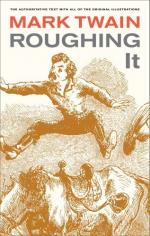Gridley sold the sack in Carson city and several California towns; also in San Francisco. Then he took it east and sold it in one or two Atlantic cities, I think. I am not sure of that, but I know that he finally carried it to St. Louis, where a monster Sanitary Fair was being held, and after selling it there for a large sum and helping on the enthusiasm by displaying the portly silver bricks which Nevada’s donation had produced, he had the flour baked up into small cakes and retailed them at high prices.
It was estimated that when the flour sack’s mission was ended it had been sold for a grand total of a hundred and fifty thousand dollars in greenbacks! This is probably the only instance on record where common family flour brought three thousand dollars a pound in the public market.
It is due to Mr. Gridley’s memory to mention that the expenses of his sanitary flour sack expedition of fifteen thousand miles, going and returning, were paid in large part if not entirely, out of his own pocket. The time he gave to it was not less than three months. Mr. Gridley was a soldier in the Mexican war and a pioneer Californian. He died at Stockton, California, in December, 1870, greatly regretted.
CHAPTER XLVI.
There were nabobs in those days—in the “flush times,” I mean. Every rich strike in the mines created one or two. I call to mind several of these. They were careless, easy-going fellows, as a general thing, and the community at large was as much benefited by their riches as they were themselves—possibly more, in some cases.
Two cousins, teamsters, did some hauling for a man and had to take a small segregated portion of a silver mine in lieu of $300 cash. They gave an outsider a third to open the mine, and they went on teaming. But not long. Ten months afterward the mine was out of debt and paying each owner $8,000 to $10,000 a month—say $100,000 a year.
One of the earliest nabobs that Nevada was delivered of wore $6,000 worth of diamonds in his bosom, and swore he was unhappy because he could not spend his money as fast as he made it.
Another Nevada nabob boasted an income that often reached $16,000 a month; and he used to love to tell how he had worked in the very mine that yielded it, for five dollars a day, when he first came to the country.
The silver and sage-brush State has knowledge of another of these pets of fortune—lifted from actual poverty to affluence almost in a single night—who was able to offer $100,000 for a position of high official distinction, shortly afterward, and did offer it—but failed to get it, his politics not being as sound as his bank account.




